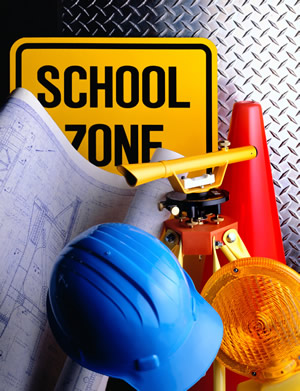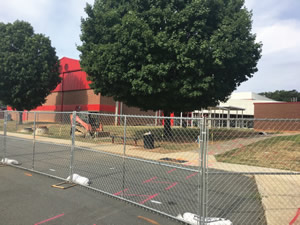Bookbags and Hardhats Don't Mix

PHOTO © JIM BARBER
The best way to execute a successful construction project in an occupied school is planning to avoid it. Construction activities with students and staff on site is a last resort. The project will cost more, take longer and keep everyone up at night concerned about the safety and well-being of the children. Instructional environments for school children and working environments for construction workers are different as day and night. But when there are no better alternatives, here are some helpful suggestions.
Include a larger and more diverse group of people than normal when planning the project. Other department representatives should be added to the usual construction management team. Transportation, child nutrition, safety and security, technology are among those departments to be included. Outside agencies like the fire department, the health department, and the permitting and inspections department should also have increased involvement. Clearly, the role of the school’s leadership team increases significantly in every phase of the project.
The principal should be involved as soon as initial project planning meetings begin. It will be fortunate for everyone if school leadership has experience with a construction project and all the little things that can disrupt each instructional day. When construction gets underway, their experience will help them understand exactly what is supposed to happen and the daily decisions that must be made in order to make the school run smoothly.
Communication is a particularly sensitive issue during an occupied construction project. During the course of the project, the principal and the contractor often communicate on a daily basis. There can be a fine line between simply exchanging information and directing the project. The principal may want additional safety measures or a change to the project phasing. Because these requests may incur additional costs, they must be handled and documented through proper channels. Otherwise, the district could face expensive change orders or issues with contract administration. And although the construction management team is known to the staff, communications and directives to teachers, staff and students should come directly from the principal.
The presence of construction workers within sight or hearing range of school children can present problems of a different sort. The observed activities of construction workers must be strictly managed. Most school construction contracts cover the behavior of workers while on school grounds including physical appearance, smoking, prohibited use of alcohol or drugs, firearms, etc. On an occupied site, enforcement of these requirements is more important than ever. The contractor should closely monitor all of their employees to avoid inappropriate contact with students and school staff. In many states there may be specific laws such as compliance with the Jessica Lunsford Act requiring the contractor to provide background checks for all workers. An open line of communications between the contractor and school officials is necessary to resolve any and all infractions.

Avoiding danger. Construction activities with students and staff on site is a last resort. Communication is a particularly sensitive issue during an occupied construction project. During the course of the project, the principal and the contractor often communicate on a daily basis. The presence of construction workers within sight or hearing range of school children can present problems of a different sort. The observed activities of construction workers must be strictly managed. There is no substitute for a careful and detailed planning process that includes a broader group of stakeholders involved early and during every phase of the project.
During the school day there must be complete separation between construction activities and the routine operation of the school, specifically the movement of students throughout the day. The older the students, the more complex this becomes with extra-curricular activities, student parking, etc. Construction lay-down areas, crew parking, and equipment movement should be separated from the routine traffic patterns used for buses, parent drop off areas, staff parking and student parking. As the work proceeds, this plan may need to be modified several times. Consider restricting construction related traffic an hour before the start of school and at least a half hour after the students are dismissed. Bookbags and hardhats should never be seen in the same place. Interior and exterior barriers should be documented on the construction drawings for each phase of the project along with details for signage and instructions concerning how temporary entryways will be secured.
Planning should also include the school’s emergency procedures and how they might be impacted by the construction project. School administrators must be prepared at any given moment to provide for the safety and well-being of children and staff in response to a wide range of circumstances. The concept of egress may not be fully understood by building contractors. If the school were to catch fire during any point of the school day, can several hundred children safely exit the building by routes they routinely practice during fire drills? Security is equally important. Administrators go to great lengths to control access to occupied school buildings. Both temporary and permanent entrances must be secured or otherwise monitored. There may be other emergency plans that need to be considered such as tornado drills.
Construction related noise, indoor air quality, or potential loss of water or power during the school day must be anticipated and contingency plans created. It may be necessary to perform certain construction activities at night or on weekends to avoid disruption of the school day. The list of things that might go wrong on a construction project grows exponentially when work takes place while children and teachers are in the building. The safety and comfort of occupants as well as maintaining an optimal learning environment are critical for a successful project.
When possible, construction in occupied schools should be avoided. When not possible, there is no substitute for a careful and detailed planning process that includes a broader group of stakeholders involved early and during every phase of the project from start to finish. Every effort must be made to prevent disruption to the learning environment or possible injury to the students and staff members.
This article originally appeared in the School Planning & Management July/August 2018 issue of Spaces4Learning.
About the Authors
Andrew LaRowe is president of EduCon Educational Consulting located in Winston Salem, N.C. He can be reached at [email protected]
Mike Raible is founder and CEO of The School Solutions Group in Charlotte, N.C., and the author of "Every Child, Every Day: Achieving Zero Dropouts Through Performance-Based Education". He can be reached at [email protected].